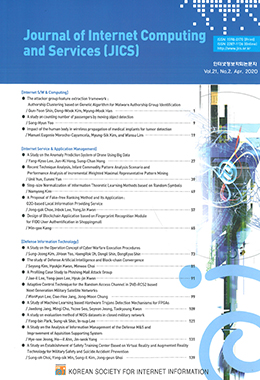해상 객체 인식은 자율운항선박(MASS)의 지능형 보조 시스템으로써, 선장이 육안으로 해상 주변의 충돌 위험성이 있는 부유물을 확인하던 정보를 컴퓨터를 통해 자동으로 인식하여 사람이 확인하는 방법과 유사한 정확도로 인지하는 방법을 말한다. 선박 주변의 물체를 인식하는 방법으로 기존에는 레이더나 소나와 같은 장치로부터 수집된 정보를 통해 확인하였지만, 인공지능의 기술이 발달하면서 선박 지능형 CCTV를 통해 운항 항로에 있는 다양한 부유물을 인식하는 것이 가능하다. 하지만, 자율 선박의 다양한 요구사항과 복잡성 때문에 영상 데이터의 처리속도가 느려지게 된다면 원활한 서비스 지원은 물론 안전성도 보장할 수 없게 된다. 이러한 문제를 해결하고자 본 논문에서는 해상 객체를 검출하는 데 있어 영상 데이터의 연산량을 최소화하여 처리속도를 높이기 위한 연구를 진행하였다. 해상 객체 인식의 관심 영역을 확보하기 위해서는 일반적으로 수평선을 찾는데 기존 연구들은 허프 변환 알고리즘을 활용하지만 본 논문에서는 속도를 개선하기 위해 이진화 알고리즘을 최적화하여 실제 객체의 위치와 유사한 영역을 찾는 새로운 방법을 제안한다. 또한, 제안하는 방법의 유용성을 증명하기 위해 딥러닝 CNN을 활용하여 해상 객체 인식 시스템을 구현함으로써 알고리즘의 성능을 평가하였다. 제안하는 알고리즘은 기존 방법의 인식 정확도를 유지하면서 약 4배 이상의 빠른 성능을 얻을 수 있었다.
A maritime object detection system is an intelligent assistance system to maritime autonomous surface ship(MASS). It detects automatically floating debris, which has a clash risk with objects in the surrounding water and used to be checked by a captain with a naked eye, at a similar level of accuracy to the human check method. It is used to detect objects around a ship. In the past, they were detected with information gathered from radars or sonar devices. With the development of artificial intelligence technology, intelligent CCTV installed in a ship are used to detect various types of floating debris on the course of sailing. If the speed of processing video data slows down due to the various requirements and complexity of MASS, however, there is no guarantee for safety as well as smooth service support. Trying to solve this issue, this study conducted research on the minimization of computation volumes for video data and the increased speed of data processing to detect maritime objects. Unlike previous studies that used the Hough transform algorithm to find the horizon and secure the areas of interest for the concerned objects, the present study proposed a new method of optimizing a binarization algorithm and finding areas whose locations were similar to actual objects in order to improve the speed. A maritime object detection system was materialized based on deep learning CNN to demonstrate the usefulness of the proposed method and assess the performance of the algorithm. The proposed algorithm performed at a speed that was 4 times faster than the old method while keeping the detection accuracy of the old method.




